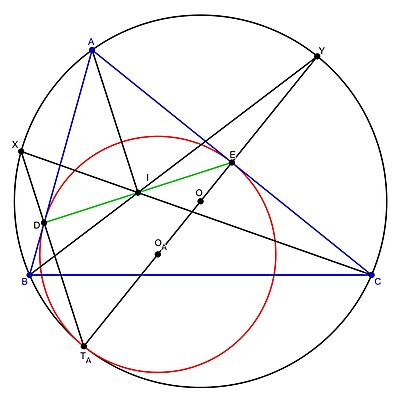Mixtilinear incircles of a triangle
In plane geometry, a mixtilinear incircle of a triangle is a circle which is tangent to two of its sides and internally tangent to its circumcircle. The mixtilinear incircle of a triangle tangent to the two sides containing vertex [math]\displaystyle{ A }[/math] is called the [math]\displaystyle{ A }[/math]-mixtilinear incircle. Every triangle has three unique mixtilinear incircles, one corresponding to each vertex.
Proof of existence and uniqueness
The [math]\displaystyle{ A }[/math]-excircle of triangle [math]\displaystyle{ ABC }[/math] is unique. Let [math]\displaystyle{ \Phi }[/math] be a transformation defined by the composition of an inversion centered at [math]\displaystyle{ A }[/math] with radius [math]\displaystyle{ \sqrt{AB \cdot AC} }[/math] and a reflection with respect to the angle bisector on [math]\displaystyle{ A }[/math]. Since inversion and reflection are bijective and preserve touching points, then [math]\displaystyle{ \Phi }[/math] does as well. Then, the image of the [math]\displaystyle{ A }[/math]-excircle under [math]\displaystyle{ \Phi }[/math] is a circle internally tangent to sides [math]\displaystyle{ AB, AC }[/math] and the circumcircle of [math]\displaystyle{ ABC }[/math], that is, the [math]\displaystyle{ A }[/math]-mixtilinear incircle. Therefore, the [math]\displaystyle{ A }[/math]-mixtilinear incircle exists and is unique, and a similar argument can prove the same for the mixtilinear incircles corresponding to [math]\displaystyle{ B }[/math] and [math]\displaystyle{ C }[/math].[1]
Construction
The [math]\displaystyle{ A }[/math]-mixtilinear incircle can be constructed with the following sequence of steps.[2]
- Draw the incenter [math]\displaystyle{ I }[/math] by intersecting angle bisectors.
- Draw a line through [math]\displaystyle{ I }[/math] perpendicular to the line [math]\displaystyle{ AI }[/math], touching lines [math]\displaystyle{ AB }[/math] and [math]\displaystyle{ AC }[/math] at points [math]\displaystyle{ D }[/math] and [math]\displaystyle{ E }[/math] respectively. These are the tangent points of the mixtilinear circle.
- Draw perpendiculars to [math]\displaystyle{ AB }[/math] and [math]\displaystyle{ AC }[/math] through points [math]\displaystyle{ D }[/math] and [math]\displaystyle{ E }[/math] respectively and intersect them in [math]\displaystyle{ O_A }[/math]. [math]\displaystyle{ O_A }[/math] is the center of the circle, so a circle with center [math]\displaystyle{ O_A }[/math] and radius [math]\displaystyle{ O_AE }[/math] is the mixtilinear incircle
This construction is possible because of the following fact:
Lemma
The incenter is the midpoint of the touching points of the mixtilinear incircle with the two sides.
Proof
Let [math]\displaystyle{ \Gamma }[/math] be the circumcircle of triangle [math]\displaystyle{ ABC }[/math] and [math]\displaystyle{ T_A }[/math] be the tangency point of the [math]\displaystyle{ A }[/math]-mixtilinear incircle [math]\displaystyle{ \Omega_A }[/math] and [math]\displaystyle{ \Gamma }[/math]. Let [math]\displaystyle{ X \neq T_A }[/math] be the intersection of line [math]\displaystyle{ T_AD }[/math] with [math]\displaystyle{ \Gamma }[/math] and [math]\displaystyle{ Y \neq T_A }[/math] be the intersection of line [math]\displaystyle{ T_AE }[/math] with [math]\displaystyle{ \Gamma }[/math]. Homothety with center on [math]\displaystyle{ T_A }[/math] between [math]\displaystyle{ \Omega_A }[/math] and [math]\displaystyle{ \Gamma }[/math] implies that [math]\displaystyle{ X, Y }[/math] are the midpoints of [math]\displaystyle{ \Gamma }[/math] arcs [math]\displaystyle{ AB }[/math] and [math]\displaystyle{ AC }[/math] respectively. The inscribed angle theorem implies that [math]\displaystyle{ X, I, C }[/math] and [math]\displaystyle{ Y, I, B }[/math] are triples of collinear points. Pascal's theorem on hexagon [math]\displaystyle{ XCABYT_A }[/math] inscribed in [math]\displaystyle{ \Gamma }[/math] implies that [math]\displaystyle{ D, I, E }[/math] are collinear. Since the angles [math]\displaystyle{ \angle{DAI} }[/math] and [math]\displaystyle{ \angle{IAE} }[/math] are equal, it follows that [math]\displaystyle{ I }[/math] is the midpoint of segment [math]\displaystyle{ DE }[/math].[1]
Other properties
Radius
The following formula relates the radius [math]\displaystyle{ r }[/math] of the incircle and the radius [math]\displaystyle{ \rho_A }[/math] of the [math]\displaystyle{ A }[/math]-mixtilinear incircle of a triangle [math]\displaystyle{ ABC }[/math]:[math]\displaystyle{ r = \rho_A \cdot \cos^2{\frac{\alpha}{2}} }[/math]
where [math]\displaystyle{ \alpha }[/math] is the magnitude of the angle at [math]\displaystyle{ A }[/math].[3]
Relationship with points on the circumcircle
- The midpoint of the arc [math]\displaystyle{ BC }[/math] that contains point [math]\displaystyle{ A }[/math] is on the line [math]\displaystyle{ T_AI }[/math].[4][5]
- The quadrilateral [math]\displaystyle{ T_AXAY }[/math] is harmonic, which means that [math]\displaystyle{ T_AA }[/math] is a symmedian on triangle [math]\displaystyle{ XT_AY }[/math].[1]
[math]\displaystyle{ T_ABDI }[/math] and [math]\displaystyle{ T_ACEI }[/math] are cyclic quadrilaterals.[4]
Spiral similarities
[math]\displaystyle{ T_A }[/math] is the center of a spiral similarity that maps [math]\displaystyle{ B, I }[/math] to [math]\displaystyle{ I, C }[/math] respectively.[1]
Relationship between the three mixtilinear incircles
Lines joining vertices and mixtilinear tangency points
The three lines joining a vertex to the point of contact of the circumcircle with the corresponding mixtilinear incircle meet at the external center of similitude of the incircle and circumcircle.[3] The Online Encyclopedia of Triangle Centers lists this point as X(56).[6] It is defined by trilinear coordinates: [math]\displaystyle{ \frac{a}{c+a-b} : \frac{b}{c+a-b} : \frac{c}{a+b-c}, }[/math] and barycentric coordinates: [math]\displaystyle{ \frac{a^2}{c+a-b} : \frac{b^2}{c+a-b} : \frac{c^2}{a+b-c}. }[/math]
Radical center
The radical center of the three mixtilinear incircles is the point [math]\displaystyle{ J }[/math] which divides [math]\displaystyle{ OI }[/math] in the ratio: [math]\displaystyle{ OJ:JI=2R:-r }[/math]where [math]\displaystyle{ I, r, O, R }[/math] are the incenter, inradius, circumcenter and circumradius respectively.[5]
References
- ↑ 1.0 1.1 1.2 1.3 Baca, Jafet. "On Mixtilinear Incircles". https://www.awesomemath.org/wp-pdf-files/math-reflections/mr-2020-02/mr_2_2020_mixtilinear.pdf.
- ↑ Weisstein, Eric W.. "Mixtilinear Incircles" (in en). https://mathworld.wolfram.com/MixtilinearIncircles.html.
- ↑ 3.0 3.1 Yui, Paul (April 23, 2018). "Mixtilinear Incircles". The American Mathematical Monthly 106 (10): 952–955. doi:10.1080/00029890.1999.12005146. https://www.tandfonline.com/doi/pdf/10.1080/00029890.1999.12005146. Retrieved October 27, 2021.
- ↑ 4.0 4.1 Chen, Evan (2016). Euclidean Geometry in Mathematical Olympiads. United States of America: MAA. pp. 68. ISBN 978-1-61444-411-4.
- ↑ 5.0 5.1 Nguyen, Khoa Lu (2006). "On Mixtilinear Incircles and Excircles". https://forumgeom.fau.edu/FG2006volume6/FG200601.pdf.
- ↑ "ENCYCLOPEDIA OF TRIANGLE CENTERS". https://faculty.evansville.edu/ck6/encyclopedia/etc.html.
 |



